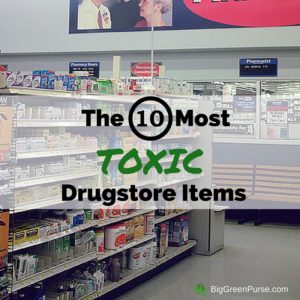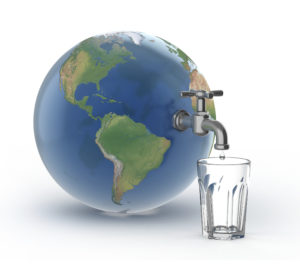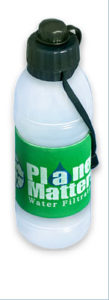“A vast array of pharmaceuticals -including antibiotics, anti-convulsants, mood stabilizers and sex hormones – have been found in the drinking water supplies of at least 41 million Americans,” an Associated Press investigation shows. Water in 24 metropolitan areas, including Detroit, Louisville, southern California and Northern New Jersey is particularly at risk.
The report says the concentrations of these pharmaceuticals are “tiny.” But it also points out that “the presence of so many prescription drugs – and over-the-counter medicines like acetaminophen and ibuprofen – in so much of our drinking water is heightening worries among scientists of long-term consequences to human health.” Those consequences could include reproductive irregularities, the early onset of puberty, and increasing resistance to antibiotics.
The drugs get into our water in several ways. Since our bodies don’t absorb a hundred percent of the drugs we take, we naturally excrete the excess when we urinate. Many Americans flush unused prescriptions and over-the-counter drugs down the toilet. Wastewater treatment plants do a poor job of capturing these chemicals before the water is either sent back out to its original source or cycled back into a region’s water supply.
The wildlife impact of these pharmaceuticals – which also include narcotics, birth control drugs, and antidepressants – is reported in Big Green Purse: Use Your Spending Power to Create a Cleaner, Greener World. Studies by the U.S. Geological Survey and the Environmental Protection Agency, notes the book, have found fish, frogs, and other aquatic animals sporting both male and female sex organs, freaks of nature attributed primarily to the rising drug levels being measured in rivers, lakes and streams.
Though the AP report and other studies are likely to fuel the craze for bottled water, they shouldn’t. Much bottled water is actually filled with tap water and is therefore likely to be just as drug-addled.
Instead, consumers should consider installing filters that use activated carbon and ozone, substances that are used in Europe to remove drugs from drinking water.
Meanwhile, consumers faced with disposing of leftover drugs should return them to the pharmacy for proper disposal. Barring this, the federal government recommends mixing them with old coffee grounds, cat litter or other trash that makes them difficult to consume before putting them in a nondescript, sealed container and throwing them in the trash. Do not flush them down the toilet.
It is worth noting that, despite the AP report, pharmaceuticals have been showing up in drinking water for at least 20 years. It is time to upgrade municipal water systems to protect people from the onslaught of chemicals they may be unwittingly ingesting every day. It is also imperative to launch a national “give back” campaign to get citizens to return unused drugs to their point of purchase. Alternatively, cities could mount a “pharmaceutical pick-up” the way many of them now sponsor an annual hazardous waste pick-up.
Municipalities can learn from what environmental organizations are already doing. Last Earth Day (April 21, 2007), the Superior Watershed Partnership in northern Michigan collected over one ton of unwanted pharmaceuticals in just three hours.
















3 thoughts on “Drinking Water Contaminated by Pharmaceuticals; Bottled Water Not the Answer”
Diane,
Thank you for being on top of the drugs-in-tap water issue.
It is surprising we aren’t all drug addicts by now (said partly in jest), considering that:
(1) millions of people take prescription or over-the-counter or illegal drugs and …
(2) potentially everyone could ingest drugs taken by other people when their drug-tainted waste enters the sewage system and comes out as tap water for public consumption and …
(3) potentially everyone could ingest drugs from the waste of wildlife who drink drug-tainted water and then excrete it in places where it could filter into rivers and streams and thus into our tap water systems and …
(4) potentially everyone could ingest drugs from the waste of livestock who are given all kinds of drugs and then extrete those drugs in places where they could filter into rivers and streams and thus into our tap water systems and …
(5) what few of us recognize, millions of people the flesh of livestock who are fed tons of drugs to make them grow faster, bulk up, and produce more milk and eggs.
So even if all the proposed solutions for preventing drugs in tapwater are adopted and enforced, drugs still enter the human system via the flesh, dairy and eggs people eat.
Not incidentally, these fat-cat, deceptive animal-exploiting industries do NOT want us to know that. (I realize that’s why you, Diane, promote organic meat, dairy and egg products, but even organically raised animals are not treated humanely — that is, as we humans would want to be treated — at some point in their quick trip from birth to death.)
Here’s a good editorial on the drugs-in-water subject: http://www.csmonitor.com/2008/0311/p08s01-comv.htm
Thankyou Diane,
it seems, as is becoming more and more prevalent, that we as individuals, consumers, community are required to be even more accountable for our own health by becoming our own ” scientists”.
The positive spin on this is that as awareness grows the masses will be more inclined to act by being far more conscious of water at their own home which hopefully will spark more actions on self sufficiency. Then hopefully over time the decline in fresh food purchases at supermarkets will decline until the big players respond.
Maybe an ideal scenario but momentum is building. Water health will obviously be key in this.
Thanks for your huge contribution to our awareness.
Dane
http://www.watershed1.com
Wow…just…wow. That is seriously disturbing. We drink only bottled water around my house, but now I’m concerned. I think I’ll have to start checking water filter prices…
Comments are closed.